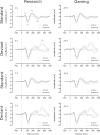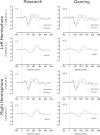Validation of the Emotiv EPOC(®) EEG gaming system for measuring research quality auditory ERPs
- PMID: 23638374
- PMCID: PMC3628843
- DOI: 10.7717/peerj.38
Validation of the Emotiv EPOC(®) EEG gaming system for measuring research quality auditory ERPs
Abstract
Background. Auditory event-related potentials (ERPs) have proved useful in investigating the role of auditory processing in cognitive disorders such as developmental dyslexia, specific language impairment (SLI), attention deficit hyperactivity disorder (ADHD), schizophrenia, and autism. However, laboratory recordings of auditory ERPs can be lengthy, uncomfortable, or threatening for some participants - particularly children. Recently, a commercial gaming electroencephalography (EEG) system has been developed that is portable, inexpensive, and easy to set up. In this study we tested if auditory ERPs measured using a gaming EEG system (Emotiv EPOC(®), www.emotiv.com) were equivalent to those measured by a widely-used, laboratory-based, research EEG system (Neuroscan). Methods. We simultaneously recorded EEGs with the research and gaming EEG systems, whilst presenting 21 adults with 566 standard (1000 Hz) and 100 deviant (1200 Hz) tones under passive (non-attended) and active (attended) conditions. The onset of each tone was marked in the EEGs using a parallel port pulse (Neuroscan) or a stimulus-generated electrical pulse injected into the O1 and O2 channels (Emotiv EPOC(®)). These markers were used to calculate research and gaming EEG system late auditory ERPs (P1, N1, P2, N2, and P3 peaks) and the mismatch negativity (MMN) in active and passive listening conditions for each participant. Results. Analyses were restricted to frontal sites as these are most commonly reported in auditory ERP research. Intra-class correlations (ICCs) indicated that the morphology of the research and gaming EEG system late auditory ERP waveforms were similar across all participants, but that the research and gaming EEG system MMN waveforms were only similar for participants with non-noisy MMN waveforms (N = 11 out of 21). Peak amplitude and latency measures revealed no significant differences between the size or the timing of the auditory P1, N1, P2, N2, P3, and MMN peaks. Conclusions. Our findings suggest that the gaming EEG system may prove a valid alternative to laboratory ERP systems for recording reliable late auditory ERPs (P1, N1, P2, N2, and the P3) over the frontal cortices. In the future, the gaming EEG system may also prove useful for measuring less reliable ERPs, such as the MMN, if the reliability of such ERPs can be boosted to the same level as late auditory ERPs.
Keywords: Auditory odd-ball; EEG; ERP; Emotiv EPOC; Intraclass correlation; MMN; Methods; Mismatch negativity; Signal processing; Validation.
Figures



References
LinkOut - more resources
Full Text Sources
Other Literature Sources
Medical

